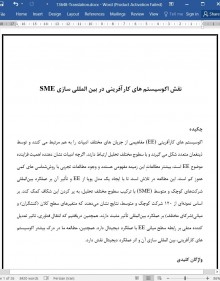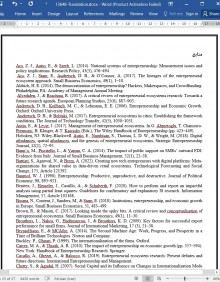
دانلود مقاله نقش اکوسیستم های کارآفرینی در بین المللی سازی SME
چکیده
اکوسیستم های کارآفرینی (EE) مفاهیمی از جریان های مختلف ادبیات را به هم مرتبط می کنند و توسط ذینفعان متعدد شکل می گیرند و با سطوح مختلف تحلیل ارتباط دارند. اگرچه ادبیات نشان دهنده اهمیت فزاینده موضوع EE است، بیشتر مطالعاتِ این زمینه مفهومی هستند و وجود مطالعات تجربی با روششناسی های کمی هنوز کم است. این مطالعه در تلاش است تا با ایجاد یک مدل پویا از EE و تأثیر آن بر عملکرد بینالمللی شرکتهای کوچک و متوسط (SME) با ترکیب سطوح مختلف تحلیل، به پر کردن این شکاف کمک کند. بر اساس نمونهای از 120 شرکت کوچک و متوسط، نتایج نشان میدهند که متغیرهای سطح کلان (کنشگران) و میانی(شرکای مختلف) بر عملکرد بینالمللی تأثیر مثبت دارند. همچنین دریافتیم که انتقال فناوری، تاثیر تعدیل کننده منفی بر رابطه سطح میانی EE با عملکرد دیجیتال دارد. همچنین، مطالعه ما در درک بیشتر اکوسیستم های کارآفرینی، بین المللی سازی آن و اثر عملکرد دیجیتال نقش دارد.
1. مقدمه
به عقیده OECD (2014)، یک اکوسیستم کارآفرینی (EE) به معنای مجموعه ای از بازیگران کارآفرین به هم مرتبط (بالقوه و موجود)، سازمان ها (به عنوان مثال انواع شرکت ها، سرمایه گذاری خطرپذیر)، نهادها (دانشگاه ها) و فرآیندهای کسب و کار (به عنوان مثال، نرخ تولد کارآفرینی) می باشد که به طور رسمی و غیررسمی گرد هم می آیند، عملکرد را در محیط کارآفرینی محلی کنترل می کنند. در این راستا، و همانگونه که او کان و همکاران (2021) بیان می کنند،EE شامل چندین لایه است که با هم وجود دارند و به طور همزمان تکامل می یابند، تئودوراکی و مسیگهم(2017) از سطح کلان برای توصیف EE، سطح میانی برای توصیف اکوسیستم حمایت از کارآفرینی و از سطح خرد برای توصیف پیشران رشد کسب و کار استفاده می کنند.
با در نظر گرفتن این موارد، استنباط میکنیم که ممکن است بر حسب ویژگیهای محیطی که هر اکوسیستم در آن قرار دارد، چندین مدل از EE وجود داشته باشد. بنابراین، نیاز است یک رویکرد سیستمی به کارآفرینی(آکز و همکاران، 2014) داشته باشیم، چرا متنوع ترین مطالعات در زمینه EE به وجود آمده است(آلودالن و باچما، 2017؛ مالکی، 2018؛ کاوالو و همکاران، 2019؛ کاهل و همکاران، 2020؛ تئودوراکی و کاتانزارو، 2021؛ جانسون و همکاران، 2022). این مطالعات اساسا بر تعامل ویژگیها و پویایی های چندجانبه استراتژیک میان بازیگران مختلف EE(تئودوراکی و همکاران، 2018)، ویژگیهای فرهنگی محلی(آدرچ و بلیتسکی، 2017)، تکامل اکوسیستم(مک و مایر، 2016)، فرآیندها (اشپیگل و هریسون، 2018)؛ حاکمیت اکوسیستم(کولومبلی و همکاران، 2019)؛ پایداری(راپوسو و همکاران، 2021)، رویکرد چند سطحی (تئودوراکی و مسیگهم، 2017) و رابطه EE با توسعه منطقه ای (آدرچ و بلیتسکی، 2017) تمرکز داشته اند.
6. نتیجه گیری
مطالعه ما توسعه یک مدل پویای در حال توسعه از EE پیشنهاد میکند که سطوح مختلف تحلیل (کلان، میانی و خرد) را برای ارزیابی تأثیر آن بر عملکرد بینالمللی SMEها و بررسی تأثیر میانجی دیجیتالی شدن بر عملکرد بینالمللی در این شرکتها ترکیب می کند. بدین منظور، به طور تجربی به بررسی بعد عملکرد EE بینالمللی و اثر تعدیلکننده فناوریهای انتقال دیجیتال پرداختیم.
نتیجه می گیریم که کنشگران پشتیبان کننده و شرکای مختلف در اکوسیستم، نقش کلیدی در عملکرد بین المللی بهتر ایفا می کنند. متغیرهای کلان و میانی EE تاثیر مثبت بر عملکرد بینالمللی SMEها دارند و فناوری نیز نقش حیاتی ایفا میکند و تاثیر مثبت بر عملکرد بینالمللی آنها دارد.
نتایج ما، همانند سایر مطالعات، محدودیت هایی نیز دارد. نمونه مورد استفاده تنها از یک کشور است، که تعمیم پذیری نتابج را محدود می کند و با سایر کسب و کار و روابط منطقه ای قابل مقایسه نیست. تنها یک تحقیق را می شناسیم (تئودورانکی و کاتانروزا، 2021) که این متغیرها را گرچه به صورت کیفی، بررسی نمود.
در همین راستا، تحقیقات آتی باید بررسی های جدیدی روی EE و عملکرد بین المللی انجام دهند و نمونه های کشورهای مختلف را در مطالعات خود مد نظر قرار دهند، بنابراین می توان با سایر زمینه های منطقه ای متفاوت، مقایسه انجام داد. دیگر سیر تحقیقاتی آتی مرتبط، بررسی نقش دولت از منظر بین المللی جهت بررسی اثربخشی حمایت نهادی برای بین المللی سازی EE است.
در آخر، بر این باوریم که تحقیقات ما، برای این حوزه آکادمیک، یک چارچوب نظری جامع و قوی برای تحقیقات آتی در زمینه SOEs و عملکرد بین المللی شرکت ها فراهم می کند.
Abstract
The Entrepreneurial Ecosystems (EE) articulate concepts from various streams of literature and are formed by multiple stakeholders and relate to different levels of analysis. Although the literature shows a growing relevance on the theme of EE, most studies reveal to be conceptual, and the existence of empirical studies with quantitative methodologies is still scarce. This study attempts to contribute to filling this gap by developing a dynamic model of EE and its impact on the small and medium-sized enterprises (SME) international performance by aggregating different levels of analysis. Based on a sample of 120 SMEs, the results suggest that macro (agents) and meso (different partners) level variables positively impact international performance. We also find that technology transfer has a negative moderating effect on the meso level relationship of EE with digital performance. Our study also contributes to a greater understanding of the Entrepreneurial Ecosystems, its internationalization and the digital performance effect.
1. Introduction
According to the OECD (2014), an entrepreneurial ecosystem (EE) is a set of interconnected entrepreneurial actors (both potential and existing), organisations (other firms, venture capital, for example), institutions (universities) and business processes (e.g., the entrepreneurial birth rate) that formally and informally come together to connect, mediate and govern performance within the local entrepreneurial environment. In this regard, and as argued by O’Kane et al. (2021), EE is composed of several layers that coexist and evolve simultaneously; Theodoraki and Messeghem (2017) use the macro level to describe the EE, the meso-level to describe the entrepreneurship support ecosystem and the micro level to describe the business incubator.
From these considerations, we deduce that there may be several models of EE, depending precisely on the characteristics of the environment where each ecosystem is inserted. From this need to attribute a systemic approach to entrepreneurship (Acs et al., 2014), the most diverse studies on EE have emerged (Alvedalen & Boschma, 2017; Malecki, 2018; Cavallo et al., 2019; Kahle et al., 2020; Theodoraki and Catanzaro, 2021; Johnson et al., 2022). These studies have essentially focused on the interactivity of attributes and strategic multilateral dynamics among the various EE actors (Theodoraki et al., 2018), local cultural specificities (Audretsch & Belitski 2017), ecosystem evolution (Mack & Mayer, 2016); processes (Spigel & Harrison, 2018); ecosystem governance (Colombelli et al., 2019); sustainability (Raposo et al., 2021), the multi-level approach (Theodoraki & Messeghem, 2017) and the relationship of EE with regional development (Audretsch & Belitski, 2017).
6. Conclusions
Our study proposes developing a dynamic model of EE aggregating different levels of analysis (macro, meso and micro) to assess its impact on SMEs’ international performance and examine the mediating effect of digitalisation on international performance in these firms. For this purpose, we empirically explored the dimension of international EE performance and the moderating effect of digital transfer technologies.
We conclude that the support agents and the various partners within the ecosystem play a key role in better international performance. The macro and meso variables of EE positively affect SMEs’ international performance, and technology also plays a vital role, positively influencing their international performance.
Notwithstanding our results, as other studies, also have limitations. The sample used is from only one country, limiting the results’ generalisation and not comparing with other business and territorial relationships. We know of only one research (Theodoraki and Catanzaro, -2021) that considers these variables, although qualitatively.
In this sense, future research should develop new investigations on EE and international performance and involve samples from different countries in the studies so that the comparison can be broadly generalised to different territorial contexts. Another pertinent future line of research is to study the role of government through the international lens to assess the effectiveness of institutional support for the EE internationalisation.
Finally, we believe that our research brings to this academic field a rigorous and comprehensive theoretical framework for future research on SOEs and the international performance of firms.
Hypothesis 1 (H1): Entrepreneurial ecosystems at the macro-level (diverse support agents) positively impact international performance.
Hypothesis 2 (H2): Entrepreneurial ecosystems at the meso-level (diverse partners) positively impact international performance.
Hypothesis 3 (H3): Entrepreneurial ecosystems at the micro-level (company characteristics) positively impact international performance.
Hypothesis 4 (H4): The implementation of digital transformation technologies moderates the impact of entrepreneurial ecosystems on international performance at the a) macro-level, b) meso-level, and c) micro-level.
فرضیه 1(H1): اکوسیستم های کارآفرینی در سطح کلان (کنشگران حمایت کننده مختلف) تأثیر مثبت بر عملکرد بین المللی دارند.
فرضیه 2(H2): اکوسیستم های کارآفرینی در سطح میانی (شرکای مختلف) تأثیر مثبت بر عملکرد بین المللی دارند.
فرضیه 3(H3): اکوسیستم های کارآفرینی در سطح خرد (ویژگی های شرکت) تأثیر مثبت بر عملکرد بین المللی دارد.
فرضیه 4(H4): پیاده سازی فناوریهای تغییرات دیجیتال، تأثیر اکوسیستمهای کارآفرینی بر عملکرد بینالمللی در سطح a) کلان، b) سطح میانی و c) سطح خرد را تعدیل میکند.
Entrepreneurial Ecosystems
Digital transformation technologies
International performance
چکیده
1. مقدمه
2. پیشینه نظری و طرح فرضیه ها
2.1. اکوسیستم های کارآفرینی
2.2. اکوسیستم های کارآفرینی و عملکرد بین المللی
2.3. رابطه بین EE و عملکرد بین المللی: نقش تعدیلگر تکنولوژی های تغییرات دیجیتال
3. روش شناسی
3.1. داده ها
3.2. معیارها
3.3. روش
4. نتایج
4.1. ارزیابی مدل اندازه گیری
5. بحث
5.1 کاربردهای نظری
5.2 کاربرد عملی
6. نتیجه گیری
منابع
Abstract
1. Introduction
2. Theoretical background and hypotheses development
2.1. Entrepreneurial ecosystems
2.2. Entrepreneurial ecosystems and international performance
2.3. Relationship between EE and international performance: Moderating role of digital transformation technologies
3. Methodology
3.1. Data
3.2. Measures
3.3. Method
4. Results
4.1. Measurement model assessment
5. Discussion
5.1. Theoretical implications
5.2. Practical implications
6. Conclusions
References
این محصول شامل پاورپوینت ترجمه نیز می باشد که پس از خرید قابل دانلود می باشد. پاورپوینت این مقاله حاوی 25 اسلاید و 6 فصل است. در صورت نیاز به ارائه مقاله در کنفرانس یا سمینار می توان از این فایل پاورپوینت استفاده کرد.
در این محصول، به همراه ترجمه کامل متن، یک فایل ورد ترجمه خلاصه نیز ارائه شده است. متن فارسی این مقاله در 10 صفحه (1850 کلمه) خلاصه شده و در داخل بسته قرار گرفته است.
علاوه بر ترجمه مقاله، یک فایل ورد نیز به این محصول اضافه شده است که در آن متن به صورت یک پاراگراف انگلیسی و یک پاراگراف فارسی درج شده است که باعث می شود به راحتی قادر به تشخیص ترجمه هر بخش از مقاله و مطالعه آن باشید. این فایل برای یادگیری و مطالعه همزمان متن انگلیسی و فارسی بسیار مفید می باشد.
بخش مهم دیگری از این محصول لغت نامه یا اصطلاحات تخصصی می باشد که در آن تعداد 45 عبارت و اصطلاح تخصصی استفاده شده در این مقاله در یک فایل اکسل جمع آوری شده است. در این فایل اصطلاحات انگلیسی (تک کلمه ای یا چند کلمه ای) در یک ستون و ترجمه آنها در ستون دیگر درج شده است که در صورت نیاز می توان به راحتی از این عبارات استفاده کرد.
- ترجمه فارسی مقاله با فرمت ورد (word) با قابلیت ویرایش و pdf بدون آرم سایت ای ترجمه
- پاورپوینت فارسی با فرمت pptx
- خلاصه فارسی با فرمت ورد (word)
- متن پاراگراف به پاراگراف انگلیسی و فارسی با فرمت ورد (word)
- اصطلاحات تخصصی با فرمت اکسل



